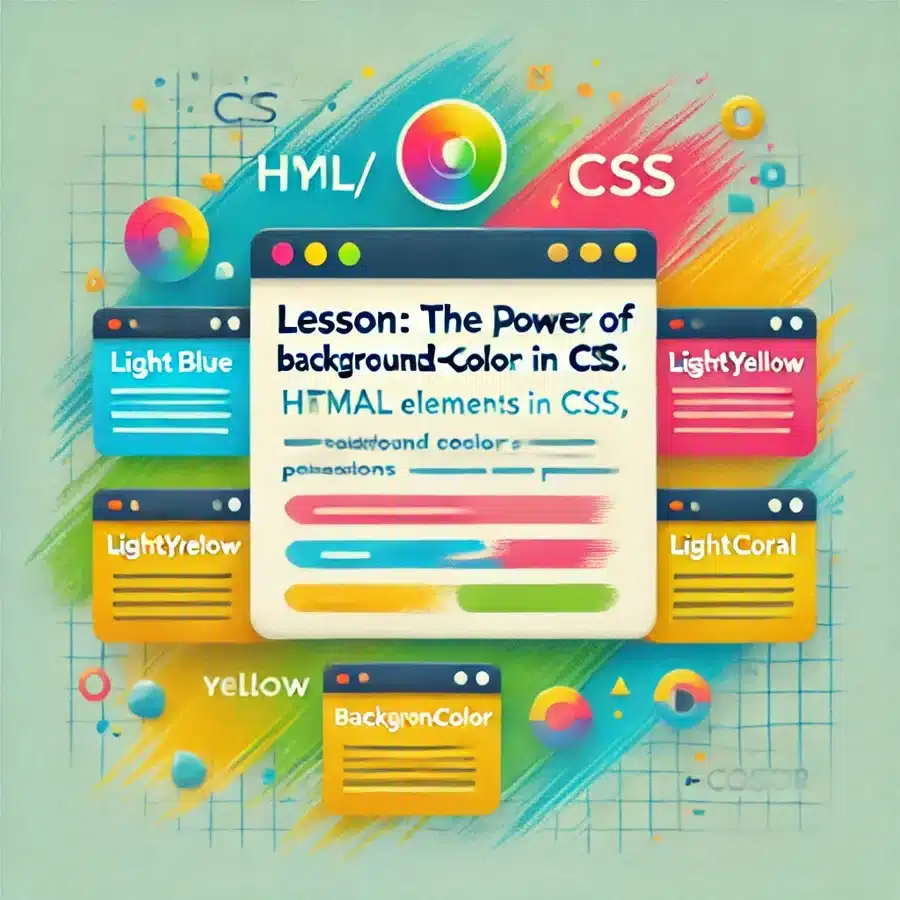
Approx. read time: 4 min.
Post: The background-color CSS property
Lesson: The Power of Background-Color in CSS
Welcome to your next step in learning CSS! 🌈
Now that you’ve started to get a hang of how CSS works, let’s explore how we can make web pages more vibrant and visually appealing. One of the easiest ways to do this is by changing the background color of different areas on your webpage. It’s like painting the walls of your website—only digitally!
Why Make Your Page Colorful?
Websites need to catch attention. Plain white pages can feel a bit dull, but adding some color can make your site more engaging and expressive. Different sections of your page, like headers, paragraphs, or entire backgrounds, can have their own unique colors!
Let’s Dive Into It! 🖌️
To change the background color of any section, we use the background-color CSS property. This property allows us to set a color behind the content of our HTML elements.
Step 1: Setting Up Your HTML
Before we can apply colors, we need some basic HTML structure. Here’s a simple example:
Hello World
This is my page.
My very first webpage
Changing colors is easy once you know the right HTML/CSS tags.
This code will render a simple page with a heading and some text. But so far, it’s just black text on a white background. Let’s change that!
Step 2: Adding Colors with CSS
To change the background color of these elements, we will use the style attribute directly in the HTML tags, like this:
Hello World
This is my page.
My very first webpage
Changing colors is easy once you know the right HTML/CSS tags.
What’s Happening Here?
- We are adding a
styleattribute to each HTML tag. - Inside the
styleattribute, we use thebackground-colorproperty to set the color. - We choose colors like
lightblue,lightgreen,lightyellow, andlightcoralas our values. You can use any color you like!
Step 3: The Result 🎨
After adding the CSS, here’s how your page will look:
- The heading will have a light blue background.
- The first paragraph will have a light green background.
- The second paragraph will have a light yellow background.
- The section inside the
will have a light coral background.
Here’s What the Code Looks Like:
Hello World
This is my page.
My very first webpage
Changing colors is easy once you know the right HTML/CSS tags.
Thousands of Colors Await You 🌈
There are countless colors you can use in CSS! You can experiment with named colors (like “lightblue”) or use more precise values like hex codes (#00FF00 for green) or RGB values (rgb(255, 0, 0) for red).
For more color options, visit W3Schools Color Reference and explore thousands of colors you can use on your site!
Conclusion: Make Your Page Shine ✨
Changing the background color with CSS is a simple yet powerful way to make your webpage stand out. Start experimenting with different colors and see how they change the feel of your site. Before you know it, you’ll be a web design pro, using colors to craft beautiful digital experiences!
Now it’s your turn—try it out and let your creativity flow! 🌟
To wrap up or expand on the lesson “The Power of Background-Color in CSS,” you can cover the following additional concepts:
1. Advanced Color Techniques
- Gradient Backgrounds: Introduce linear and radial gradients in CSS to create more dynamic and visually appealing backgrounds.
- Transparency: Teach about RGBA and HSLA color values for adding transparency to background colors.
- Custom Properties (CSS Variables): Show how to define and reuse colors with CSS variables for better manageability in large projects.
2. Responsive Design Considerations
- Media Queries: Explain how to change background colors for different screen sizes and orientations to maintain a consistent user experience across devices.
- Dark Mode: Introduce the concept of using CSS to create light and dark modes for websites, automatically adjusting background colors.
3. Color Accessibility
- Contrast Ratios: Emphasize the importance of choosing background colors that provide sufficient contrast with text to ensure readability for all users, including those with visual impairments.
- Color Blindness: Offer guidance on color choices to create color-blind-friendly designs.
4. Using Background Images
- Background Images with Colors: Combine background images and colors using the
backgroundproperty for layered effects. - Pattern Backgrounds: Introduce patterns as a way to enhance visual interest without overwhelming the user.
5. Best Practices
- Consistency: Teach the importance of using a consistent color palette throughout the website to maintain a cohesive design.
- Minimalism vs. Vibrancy: Discuss when to use subtle background colors versus bold, vibrant colors depending on the brand and user experience.
Conclusion:
In summary, background-color is a powerful CSS property that can dramatically improve the user experience and visual appeal of a website. From simple color changes to advanced techniques like gradients and responsive designs, background-color allows web designers to create dynamic and engaging digital environments. Encourage experimentation and mindful design choices to ensure that color is not just decorative, but functional.
By now, students should be equipped with the skills to apply these concepts in real-world scenarios and elevate their web development projects.









